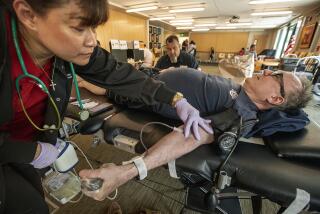Transfusion-Related AIDS Cases Grow : Doubling in Percentage Laid to Exposures Prior to Screening Test
- Share via
WASHINGTON — The percentage of AIDS cases related to blood transfusions doubled last year to 2% of all cases, the Centers for Disease Control reported Thursday, but federal health officials attributed the increase to exposures that occurred before a national blood-screening program started last year.
“We are probably just now seeing them because of the long incubation period of the disease,” said Meade Morgan, chief of the statistics branch for the CDC’s AIDS program. “People should not be concerned about accepting blood.”
Nevertheless, the report is likely to increase public fears about the safety of the nation’s blood supply, which is already suffering from a serious shortage, apparently because of concern over the AIDS epidemic. A survey released last week showed that Americans were not only worried about getting AIDS from a blood transfusion but also held the false belief that they could contract the disease from donating blood.
Increasing at Slower Rate
The agency, releasing one of its periodic updates on AIDS statistics, also reported that the disease is increasing at a slower rate: It now takes 11 months for the number of cases to double, instead of the five months first reported. CDC officials cautioned, however, that AIDS cases are still rising rapidly in all groups and that the slowdown could be caused by several factors, including decreased reporting.
“It may also mean that high-risk populations have become saturated with the virus so that few new infections are occurring,” Morgan said.
He added: “Even though the doubling time is getting longer, if the next doubling occurs, say, in another 13 months, we would still have 16,000 additional new cases of AIDS--and in terms of the absolute numbers, the rate of increase is quite large.”
The CDC said that there were 8,406 cases of AIDS reported in 1985, an increase of 84% over the previous year. In 1982, there were 747 cases; in 1983, there were 2,124 reported cases, an increase of 184%. In 1984, there were 4,569 cases reported, a jump of 115%, CDC said.
“From analyses of past trends, further increases are expected for 1986,” the agency said. “However, the percentage increase in 1986 is likely to be smaller than that noted in 1985.”
Proportion Remains Stable
The CDC said that, while cases have increased within all patient groups, “the relative proportion of AIDS cases among most risk groups has remained stable.”
“We don’t see an increase in the proportion of cases in the ‘not-at-risk’ population,” Morgan said. “The trends are constant. That should be reassuring to the heterosexual population.”
The agency said that 34 cases of transfusion-related AIDS, or 1.1% of all AIDS cases, were reported among adults before Jan. 1, 1984. But between Jan. 14, 1985, and Jan. 13, 1986, the figure rose to 171 of 8,529 cases--or 2%. In 1985, the number of transfusion-related cases reported was more than triple that of the previous year, the CDC said.
“These cases represent a second wave of infection,” Morgan said. “The first was when the virus was initially introduced into the male homosexual population, who, in turn, donated infected blood--hence, the second-wave effect.”
The procedure begun last year, known as the ELISA test, screens all blood donations for antibodies to the HTLV-III virus, which causes AIDS. Blood donations that test positive are destroyed. Because onset of the disease can be as long as seven or more years after exposure, Morgan said, the agency does not yet have solid evidence that the test has made a difference.
Test Not Perfect
“We are convinced it will,” Morgan said. “It’s just too soon to tell. The test is not 100% perfect. There are probably a few contaminated units that slip through. But the blood supply is certainly much, much cleaner than it was before.”
In a related development, the Journal of the American Medical Assn. says this week that the first two cases of AIDS in Saudi Arabia have been reported in two patients, both of whom had received transfused blood imported from the United States in 1981.
“Since an undetermined number of Saudi patients have received blood imported from the United States, an outbreak of AIDS in Saudi Arabia might prove to be a serious problem in the near future,” Drs. Harb A. Harfi and Benyamin M. Fakhry wrote in the current issue of the medical magazine.
In the United States, there has been a total of 261 transfusion-related cases among adults and 33 among children. As of Jan. 13, there were 16,458 cases of AIDS, with 8,361 deaths.
AIDS, or acquired immune deficiency syndrome, destroys the body’s immune system, leaving it powerless against otherwise rare infections. It is transmitted through sexual contact--with the exchange of bodily fluids such as semen and blood--and through the sharing of unsterilized hypodermic needles. It has also been spread to hemophiliacs through contaminated blood products, although a new heating procedure that destroys the virus has eliminated that risk.
Those at highest risk include male homosexuals and bisexuals and intravenous drug users and their steady sexual partners.
More to Read
Sign up for Essential California
The most important California stories and recommendations in your inbox every morning.
You may occasionally receive promotional content from the Los Angeles Times.













